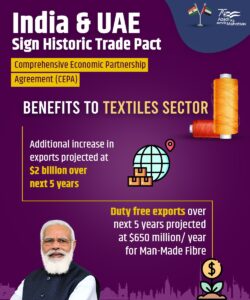In a historic way, India and the United Arab Emirates (UAE) signed a Comprehensive Economic Partnership Agreement (CEPA) o 18th February.
Crown Prince of Abu Dhabi Sheik Mohamed bin Zayed Al Nahyan and Prime Minister Narendra Modi signed this mega-deal during a virtual meeting.
Industrialists are praising the government for this move. But will it really benefit the Indian businesses?
What is the India-UAE CEPA agreement?
Historic #IndiaUAECEPA Deal Signed! 🤝
Big boost to:
💎 Gems & Jewellery Sector
🧵 Textiles Sector
💊 Pharmaceutical & Medical Devices
⚙️ Engineering ProductsCEPA will contribute towards large scale employment generation & business expansion in both countries.
🇮🇳🇦🇪 pic.twitter.com/26FYnzJobg— Piyush Goyal (@PiyushGoyal) February 18, 2022
The UAE is the second-largest exporting and trading destination for India with trading volumes of $60 billion.
It is expected that in five years, the agreement will usher in a new era in bilateral economic relations that will increase the trading volume to $100 billion.
Who will benefit from CEPA?
Indian Commerce and Industry Minister Piyush Goyal asserted that CEPA would provide a fresh opportunity to labor-intensive sectors such as gems and jewelry, textiles, leather, footwear, furniture, agriculture and food products, plastics, engineering goods, pharmaceuticals, medical devices, and sports goods.

What are the benefits of CEPA for the textile industry?
The CEPA is India’s first comprehensive trade agreement in a decade.
Also known as the Free Trade Agreement (FTA), will unleash the infinite potential that both nations hold and it will have a huge impetus to several sectors, including textiles.
As per the Indian government, the CEPA will add an additional $2 billion increase in textile exports over the next five years.
Including duty-free $650 million / year exports for Man-made fibers.
Indian textile and apparel industry will benefit hugely as they won’t be needed to pay the 5% duty on textiles and garments.
This is a huge advantage for Indian companies.
It will certainly boost exports to this region.
Below are some numbers from Textiles exports:
- Knitted garments: $1159.74 million
- Woven: $655.65 million
- Total apparel exports in 2021: $1609.4 million
- Home textiles also saw a staggering 32.46% year-over-year growth in exports to UAE.
It is also pertinent to mention here that various reports have claimed that overall India eyes the US $100 billion in the coming years.
Below is the share of India versus competing countries in UAE apparel imports:

What are the challenges to CEPA?
Even though experts called CEPA a “well balanced, fair and comprehensive partnership agreement”, there are chances for bottlenecks.
The trade experts say that India should be careful while operationalizing this agreement because the chances for it to become a challenge are higher.
- India needs to ensure that goods originating from outside the UAE are not allowed duty-free into India under this treaty.
- Since UAE is a transshipment hub and hence, India should guard against duty-free imports of transhipped goods.
- The deal could be harmful to sectors where manufacturing for the domestic market happens in India, yet a product exported from Dubai is still cheaper and better.
- Availability of raw materials and cost of raw materials in India is higher than in other countries making it difficult for manufacturers to fight at a global market and win substantial business. For example, 50% of our PVC requirement is only made in India. The rest is imported.
Deloitte’s Mani adds: ”While the sectoral impact would vary, it is essential to safeguard India’s interests in services, which have in the past been difficult to safeguard.”
Conclusion
Overall, the CEPA is a win-win situation for both India and the UAE. It will open up a lot of opportunities for MSMEs and provide job opportunities to up to 1 million Indian youth.
For woven fabric manufacturing, contact us.











